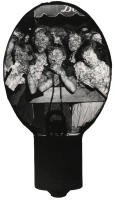In the 1980s, photographer Joseph Czarnecki began visiting Auschwitz and recording the art and graffiti he found on the walls of the concentration camp. In his book Last Traces: The Lost Art of Auschwitz, published in 1989, Czarnecki tells the stories behind these murals and inscriptions, giving us a glimpse into life in the camp.
The wall decorations Czarnecki documented fell into two basic categories: prisoner graffiti and paintings “commissioned” by the Nazis. The former included inscriptions of names and numbers, caricatures of Hitler and Mussolini, poems, and calendars. Some prisoners drew different aspects of camp life such as a portrait of the cellkeeper Jakub Kozielczuk, a man with his own tragic story who risked his life to help the prisoners he was guarding. Other drawings depict the town of Auschwitz (where prisoners were sometimes sent on work detail) and the camp barber shaving a prisoner.
 Joseph Czarnecki, Poem on the Cell Wall “Whoever in this life has not known what freedom is / Here will find it and love it.” signed K.F., Block 11, Cell 6, Main Camp, ca. 1980 (616.1989)
Joseph Czarnecki, Poem on the Cell Wall “Whoever in this life has not known what freedom is / Here will find it and love it.” signed K.F., Block 11, Cell 6, Main Camp, ca. 1980 (616.1989)
In some cases, Czarnecki was able to discover who created the graffiti. For example, Edward Galinski and Mally Zimetbaum met and fell in love at Auschwitz, becoming a source of hope to the other prisoners. After a failed escape attempt, they were imprisoned and eventually executed. Edward carved their names onto the wall of his cell, along with a portrait of his beloved Mally. Another prisoner whose graffiti we can recognize is Stefan Jasienski, a soldier and Allied spy who was captured and sent to Auschwitz in 1944. On the door of his cell, he carved symbols and drawings that represented different aspects of his life, from his education in architecture to his training as a soldier.
In contrast, many of the more elaborate paintings at Auschwitz were, in fact, “commissioned” by the Nazi guards. Prisoners with artistic experience were ordered to decorate different rooms as part of an ongoing competition among the guards to demonstrate their ability to run an orderly camp. For this reason, the guards often preferred images and slogans extolling the virtues of cleanliness and health.
 Joseph Czarnecki, The Elegant Bathroom: Painting Simulating Bathroom Mirror, by Lucjan Motyka, Block 8, second-floor washroom, Main Camp, ca. 1980 (622.1989)
Joseph Czarnecki, The Elegant Bathroom: Painting Simulating Bathroom Mirror, by Lucjan Motyka, Block 8, second-floor washroom, Main Camp, ca. 1980 (622.1989)
However, Czarnecki argues that even the paintings ordered by the Nazis reflect the attitudes of the prisoners who painted them. For instance, Lucjan Motyka, a prisoner and camp artist, viewed his own mural of an elegant bathroom with great irony. Painting scenes of luxury and wide open spaces–things antithetical to camp life–was his form of sarcastic humor with, perhaps, a touch of longing. Another painting portraying prisoners digging a canal features one distinct portrait, possibly a self-portrait, amid a sea of generic faces. The prisoner’s expression is one of disgust and loathing, presumably directed at the scene of Nazi-ordered suffering around him.
 Joseph Czarnecki, The Penal Colony “Königsgraben,” Birkenau, Block 1, ca. 1980 (612.1989)
Joseph Czarnecki, The Penal Colony “Königsgraben,” Birkenau, Block 1, ca. 1980 (612.1989)
Czarnecki’s analysis reveals how each mural may reflect a range of emotions, subversive attitudes, or prisoner perspectives. In this way, Czarnecki’s photographs document an important and often overlooked aspect of life in the concentration camps. Today, visitors to Auschwitz can still see some of the graffiti and paintings on the walls, experiencing firsthand the powerful connection between the present and the past that is forged through art.


Thank you for posting this, it is interesting, it is a part of the Holocaust I have never heard about before.